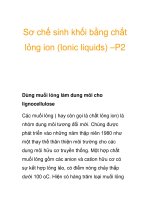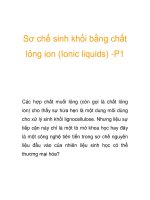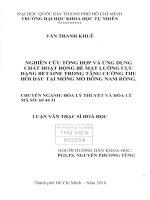Chất lỏng ion Ionic Liquids: tổng quan, tổng hợp và ứng dụng
Bạn đang xem bản rút gọn của tài liệu. Xem và tải ngay bản đầy đủ của tài liệu tại đây (2.01 MB, 61 trang )
BACK KHOA UNIVERSITY
FALCUTY OF CHEMICAL ENGINEERING
SCIENTIFIC REPORT
ADVANCEMENTS IN GREEN CHEMISTRY
Topic: IONIC LIQUIDS (ILs)
Performer:
Nguyễn Văn Tú
Nguyễn Phước Tấn
- PhD Student (51305919)
- PhD Student
Supervisor: PGS.TS Phan Thanh Sơn Nam
TPHCM, tháng 4 năm 2017
CONTENTS
An overview about Ils in Green Chemistry
Synthesis methods of ILs
Applications of ILs
2
GENERALITY OF ILs
1. What are Ionic liquids (ILs)?
2. Why consider of ILs?
3. The characteristic properties of ILs
GENERALITY OF ILs
History
1888 Gabriel and Weiner found ethanolammonium
nitrate (m.p. 52–55◦C)
1914 The “first” RTIL ethylammonium nitrate
[EtNH3][NO3] with melting point 12◦C
1948 Development of IL with chloroaluminate ions by
Hurley and Wier at the Rice Institute in Texas
1982 reported by Wilkes , A new class of RTILs that
consist of dialkylimidazolium chloroaluminate
1992 Development of air- and water-stable
imidazolium based ILs by Wilkes et al.
GENERALITY OF ILs
Development
2003
Year
2001
1999
1997
1995
0
200
400
600
800
Number of publications
1000
GENERALITY OF ILs
What are ionic liquids?
Definition:
- Simply, they are liquids that are composed entirely of
ions.
- In the broad sense, this term includes all the molten
salts, for instance, sodium chlorine at temperatures
higher than 800oC.
GENERALITY OF ILs
What are ionic liquids?
- Ionic liquids are salts that are liquid at low temperature
(<100oC) which represent a new class of solvents with
nonmolecular, ionic character.
GENERALITY OF ILs
What are ionic liquids?
Traditional salts like sodium
chloride
are
able
to
efficiently pack to form a
crystal lattice
With ionic liquids, the cations
are asymmetrically substituted
with different length groups to
prevent the packing of the
cations/anions into a crystal
lattice
GENERALITY OF ILs
Room temperature Ionic liquids
• Room temperature ionic liquids (RTIL) are salts which
are already liquid below room temperature.
• Variations in cations and anions can produce literally
millions of ionic liquids, including chiral, fluorinated,
and antibacterial IL.
• Large number of possibilities allows for fine-tuning
the ionic liquid properties for specific applications.
GENERALITY OF ILs
The driving forces
The problems in the chemical industry with the volatile
organic compounds (VOCs) :
• toxic and/or hazardous
• serious environmental issues, such as
atmospheric emissions and contamination of
aqueous effluents
The driving force in the quest for novel reaction media:
• greener processes
• recycling homogeneous catalysts
GENERALITY OF ILs
What is “green chemistry”?
- Recently ionic liquids have often been discussed as
promising solvents for “clean processes” and “green
chemistry”.
- These two catchwords means to reduce drastically
the amounts of side and coupling products and
the
solvent
processes.
and
catalyst
consumption
in
chemical
GENERALITY OF ILs
Why consider Ionic liquids ?
• ILs are environmentally-friendly alternatives to organic
solvents
for
liquid/liquid
extractions.
Catalysis,
separations, and electrochemistry.
• ILs will reduce or eliminate the related costs, disposal
requirements, and hazards associated with volatile
organic compounds (VOCs).
• The ability to fine-tune the properties of the IL medium
will allow selection of IL to replace specific solvents in a
variety of different processes.
GENERALITY OF ILs
Important IL Properties
• High ionic conductivity
• Non-flammable
• Non-volatile
• High thermal stability
• Wide temperature range for liquid phase (- 40 to + 200°C)
• Highly solvating, yet non-coordinating
• Good solvents for many organic and inorganic materials
GENERALITY OF ILs
Great promise
• Designability: By combining different anions with cations, it
is possible to generate a huge number of different ionic
liquids, each with their own specific solvent properties.
Some ionic liquids are water soluble, others are not. Some
dissolve typical organic solvents, other are not.
• They can be functionalized to act as acids, bases or ligands
and have the potential to catalyze certain reactions in
certain systems.
GENERALITY OF ILs
Great promise
• Ionic liquids are non-volatile, hence they may be used in high
vacuum systems and high temperature reactions without the
requirement of a pressure vessel to contain the vapors.
• They are good solvents for a wide range of both inorganic,
organic and polymeric materials and unusual combinations of
reagents can be brought into same phase. However they do
not dissolve glass, polyethylene, or Teflon. High solubility
usually implies small reactor volumes in the final process.
GENERALITY OF ILs
Great promise
• They are immiscible with a number of organic solvents and provide a
non-aqueous, polar alternative for two phase systems, this has been
used to effect total catalyst recovery in a number of transition metal
catalyzed reactions. Hydrophobic ionic liquids can also be used as
immiscible polar phase with water.
• They are often composed of poorly coordinating ions, so they have
the potential to be highly polar non-coordinating solvents, this is
particularly important when using transition-metal based catalysts.
GENERALITY OF ILs
Characteristics of RTIL
• Choice of cation and anion determine physical properties (e.g.
melting point, viscosity, density, water solubility, etc.)
• Cations are typically big, bulky, and asymmetric accounting
for the low melting points
• The anion contributes more to the overall characteristics of
the IL and determines the air and water stability
• Melting point can be easily changed by structural variation of
one of the ions or combining different ions
GENERALITY OF ILs
Typical RTIL Cations
• Room temperature ionic liquids consist of bulky and
asymmetric organic cations such as :
Imidazolium ion
Pyridium ion
Ammonium ion
Phosphonium ion
Scheme 1. Important types of cation
GENERALITY OF ILs
Anions for RTIL
•A wide range of anions is employed, from simple halides
which inflect high melting points, to inorganic anions such
as:
Anions:
GENERALITY OF ILs
Comparison of organic solvents with ionic liquids
TỔNG HỢP CHẤT LỎNG ION
Nguyên tắc tổng hợp chất lỏng ion
NR3
i) Tạo muối để hình thành
Giai đoạn 1
cation thích hợp
ii) Trao đổi anion để hình
thành chất lỏng ion mong
muốn
R’X
[NR3R’]+X-
Giai đoạn 2a
+ Lewis acid
MXy
Giai đoạn 2b
1.+ Muối kim loại
M+[A]- - MX
2.+ Bronsted acid
H+[A]- - HX
3.+ Nhựa trao đổi ion
[NR3R’]+ [MX y+1]
-
[NR3R’]+[A]22
TỔNG HỢP CHẤT LỎNG ION
Nguyên tắc tổng hợp chất lỏng ion
23
TỔNG HỢP CHẤT LỎNG ION
Nguyên tắc tổng hợp chất lỏng ion
• Tạo anion sử dụng Lewis acid: có nhiều anion tồn tại phụ thuộc vào
tỷ lệ mol giữa [RN3R’]+X- và Mxy
24
TỔNG HỢP CHẤT LỎNG ION
Tổng hợp chất lỏng ion họ imidazolium
• Điều chế: tạo muối trực tiếp nhờ phản ứng alkyl hóa Nmethylimidazole -> 1-alkyl-3-methylimidazole halide.
•
Tinh chế: hòa tan trong dung môi như acetonitrile hoặc
tetrahydrofuran-> xử lý với than hoạt tính -> đuổi dung môi
dưới áp suất kém.
25
TỔNG HỢP CHẤT LỎNG ION
Tổng hợp chất lỏng ion họ imidazolium
Tác giả Varma tổng hợp chất lỏng ion họ imidazolium nhờ sự
hỗ trợ của vi sóng.
26









